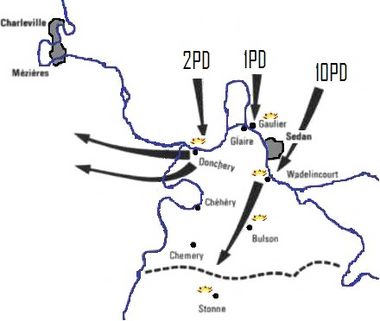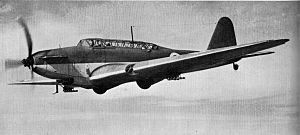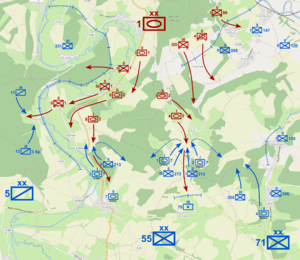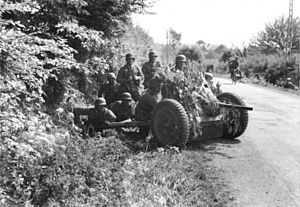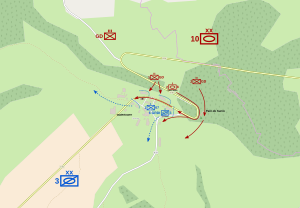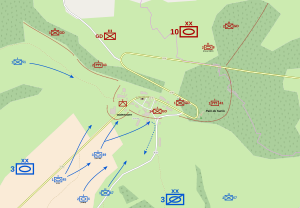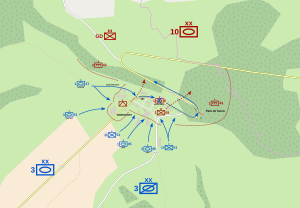Battle of Sedan (1940) facts for kids
Quick facts for kids Battle of Sedan |
|||||||
|---|---|---|---|---|---|---|---|
| Part of the Battle of France in the Western Front of World War II | |||||||
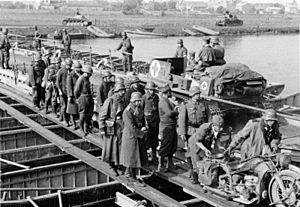 German troops with French prisoners crossing the Meuse on 15 May 1940 near Sedan |
|||||||
|
|||||||
| Belligerents | |||||||
| Commanders and leaders | |||||||
|
|
||||||
| Strength | |||||||
152 bombers
|
|
||||||
| Casualties and losses | |||||||
|
|
||||||
The Battle of Sedan (also called the Second Battle of Sedan) happened in May 1940. It was a key part of the Battle of France during World War II. German forces, known as the Wehrmacht, launched a surprise attack. Their plan, called Fall Gelb (Case Yellow), aimed to go through the Ardennes forest. This would let them surround the Allied armies in Belgium and northern France.
The German Army Group A crossed the Meuse river near Sedan. Their goal was to capture Sedan and then push west. They wanted to reach the English Channel coast. This would trap the Allied forces that were moving into Belgium.
Sedan is on the east bank of the Meuse river. Taking it would give the Germans a place to cross the river. On May 12, Sedan was captured easily. The Germans then defeated French defenses on the west bank. German air attacks, by the Luftwaffe, and low morale stopped the French from destroying the bridges. This allowed German forces to pour across the river.
On May 14, British and French air forces tried to bomb the bridges. But the Luftwaffe stopped them. The Allies lost many planes in these air battles. This weakened their bomber forces. French counter-attacks from May 15 to 17 failed due to delays and confusion. By May 20, the German Army reached the Channel. This meant they had trapped the main Allied armies, including the British. The battles that followed led to France's defeat. The British were forced to leave the continent.
Contents
Why the Battle Happened
Germany's Plan
On May 10, 1940, Germany invaded Luxembourg, the Netherlands, and Belgium. In Belgium, German forces moved quickly towards the Dyle river. The Allies, including French and British armies, moved to the Dyle river. They wanted to create a strong defense line. This was part of their Dyle Plan.
However, the German attack in Belgium was a trick. The main German attack, Fall Gelb, was through the Ardennes forest. This area in Luxembourg and southern Belgium was not heavily defended. German tanks, led by Heinz Guderian, were to attack France at Sedan. Sedan is on the Meuse river. Capturing it would open the way into France. It would also allow the Germans to get behind the Allied forces in Belgium. This plan aimed to surround and trap the Allied armies.
The German High Command gave Army Group A the most powerful tanks. They had the best machines for the Sedan attack. This showed how important Sedan was to their plan.
The "Impenetrable" Ardennes
After World War I, French generals thought tanks could not cross the Ardennes forest. Marshal Philippe Pétain called it "impenetrable." General Maurice Gamelin said it was "Europe's best tank obstacle." They believed the Meuse river and Ardennes would protect France. They thought a German attack through the Ardennes would take weeks to reach the Meuse.
But military exercises in 1938 showed this was wrong. A German-style attack easily broke through French defenses. A report in March 1940 said Sedan's defenses were "entirely inadequate." One general, André-Gaston Prételat, correctly thought tanks could cross the Ardennes easily. He estimated Germans would reach the Meuse in 60 hours. They actually did it in 57 hours.
France tried to build more defenses in late 1939. But bad winter weather stopped them. General Charles Huntziger asked for more divisions to work on defenses. His request was turned down.
French Defenses at Sedan

The French defenses at Sedan were weak. The French did not expect a major German attack there. Only the French 55th Infantry Division, a less experienced unit, was in this area. The strong Maginot Line ended 20 km (12 mi) east of Sedan. There was a gap near Stenay with no defenses.
German planes saw the French building new defenses. German commander Gerd von Rundstedt wondered if Sedan was the right place to attack. But photo experts said the "strong" defenses were just half-built bunkers. This helped Guderian's plan to attack Sedan.
General Huntziger trusted the concrete defenses. He did not believe Germans would attack through the Ardennes. Only 42 bunkers protected Sedan in September 1939. Another 61 were built by May 1940. But most were unfinished. Some lacked gun shutters or back doors. This made them easy for infantry to sneak into.
North of Sedan, the town of Glaire overlooked the river crossings. This was where German tanks would hit hardest. There was a 2 km (1.2 mi) gap between two bunkers. This allowed attackers to enter Sedan from the north.
Sedan's defenses also had almost no mines. The French Second Army had only 16,000 mines for a 70 km (43 mi) front. The 55th Infantry Division got only 422 mines. Many were not even laid.
German Approach
On May 12, German generals Ewald von Kleist and Guderian disagreed. Kleist wanted to attack further west, at Flize. He thought it would avoid two river crossings. Guderian wanted to stick to Sedan. He said attacking at Flize would put them too close to French forts. It would also delay the attack by 24 hours. Kleist agreed that delays were bad, so he accepted Guderian's plan.
Guderian wanted a large bridgehead at Sedan. He also wanted to quickly take the high ground around Sedan. His plan for May 13 was simple. The 2nd Panzer Division would be on the right flank near Donchery. The 1st Panzer Division would make the main attack. It would cross the Meuse north of Sedan and take the Marfee Heights. The 10th Panzer Division would cross south of Sedan. It would protect the southern side.
Large numbers of German troops and equipment gathered north of the Meuse. They were ready for the river crossing.
Crossing the Meuse River
Taking Sedan
Guderian's plan for Sedan relied heavily on air support. His army did not have enough artillery. German air commander Hugo Sperrle first planned a short, strong bombing. But Guderian and another air commander, Bruno Loerzer, decided on a "rolling raid." Small groups of planes would attack constantly all day. This would destroy French artillery, lower morale, and hit targets more accurately.
On May 13, the Luftwaffe launched the biggest air attack the world had seen. Dive bombers, like the Junkers Ju 87 Stuka, flew hundreds of missions. They targeted the Marfee heights behind Sedan. These heights held French artillery. German fighters also attacked to cut communications and strafe forts.
The air attacks scared the French defenders. Many gunners left their positions before the German ground attack. The Luftwaffe lost only six planes. No French bunkers were destroyed by direct hits. But the bombing cut communication cables. The psychological effect was huge. French soldiers were terrified by the Stuka's siren. This led to the "panic of Bulson." A false report of German tanks caused the 55th Infantry Division to abandon their positions.
German Crossings
The 1st Panzer Division led the main attack. They found the Luftwaffe had not destroyed all bunkers. French machine gun fire stopped them from crossing the Pont Neuf bridge in rubber boats. An 88 mm anti-aircraft gun was used to destroy a strong bunker. By nightfall, the 1st Panzer Division had pushed 8 km (5 mi) into French lines.
The 2nd Panzer Division had a harder time. Traffic delays meant they arrived late at Donchery. French artillery focused on them. All attempts to cross failed at first. But the 1st Panzer Division's success in the center helped. They attacked the French from the side. By 8:00 PM, elements of the 1st and 2nd Panzer Divisions had crossed the Meuse.
The 10th Panzer Division also struggled. They had little artillery and less air support. French artillery and machine guns were still active. Many of their rubber boats were destroyed. Only a small group of 11 engineers and infantrymen managed to break through. They knocked out seven bunkers. By the end of the day, the 10th Panzer Division had also secured its bridgehead.
Allied Air Attacks
By early May 14, German armored cars were crossing the Meuse. French reports mistakenly said tanks were crossing. This alarmed the French. General Gaston-Henri Billotte ordered all efforts to destroy the bridges. He said, "over them will pass either victory or defeat!"
British and French bombers launched attacks. But German fighters outnumbered them. The British Royal Air Force (RAF) lost many planes. Out of 71 bombers, 40 to 44 were shot down. This was a loss rate of over 50 percent. The French air force also suffered heavy losses in previous days. They flew fewer missions.
The Allied bombers faced strong German air defenses. German anti-aircraft guns, including powerful 88 mm guns, were everywhere. Allied pilots called it "hell along the Meuse." On May 14, the Allies lost 167 aircraft trying to hit one target. The German air victory was decisive. By nightfall, 600 German tanks and vehicles were across the Meuse.
French Counter-Attacks
Missed Opportunity
French commander Charles Huntziger was not worried at first. He expected French reserves to stabilize the front. The French had many tanks, including the powerful Char B1-Bis. These tanks had heavier armor and bigger guns than German tanks. But French tanks were slow and needed frequent refueling.
The Germans were vulnerable for seven hours on May 13-14. A strong French attack could have pushed them back. But French commanders were far from the front. They did not have real-time information. They also received wrong reports about German tanks already crossing. This caused delays and confusion. French artillery units retreated, abandoning many guns. This led to the "panic of Bulson." The French missed their chance to stop the German breakout.
Race to Bulson
The race for Bulson ridge began on May 13. By May 14, French tanks advanced to Bulson. They wanted to take the high ground and destroy the German bridgeheads. But the Germans had already reached the ridge minutes before.
French commander Lafontaine hesitated for 24 hours. He spent time scouting and trying to stop fleeing soldiers. He waited for an order to attack. This delay was critical. By the time he gave orders on May 14, German tanks were already advancing inland. The Germans used a system called Auftragstaktik (Mission Command). This allowed their units to act quickly without waiting for orders.
The French could have pushed the Germans back. But poor planning and slow decisions cost them. German soldiers were tired after five days of fighting. A quick French attack could have caused a "crisis" for the Germans. The French tanks were also designed to support infantry, so they were slow. The Germans, though their tanks were lighter, used their speed and radio communication to their advantage.
Battle of Bulson
The first tank battles happened at Bulson. German 37 mm anti-tank guns and Panzer IIIs struggled against the heavily armored French tanks. Several German tanks were knocked out. But German tanks used their speed and radios to move quickly. They often attacked French tanks from the rear, where their armor was weaker.
French artillery hidden in woods was very effective. One German tank company was almost wiped out. But the arrival of the Großdeutschland Infantry Regiment helped. They cleared French anti-tank lines and infantry.
On the left side of Bulson ridge, Germans met 13 French tanks. The Germans outflanked the French. By 10:45 AM, Lafontaine ordered a retreat. German 88 mm guns and heavier Panzer IIIs and IVs arrived. The French 7th Tank Battalion was destroyed. Only 10 French tanks remained out of 40. The 1st Panzer Division held a victory parade, but it was cut short when the Luftwaffe accidentally bombed them.
Battle of Stonne
The German High Command wanted to wait for infantry divisions to catch up. But Guderian ignored them. He ordered his Panzer divisions to push towards the Channel. He left the 10th Panzer Division and Großdeutschland Infantry Regiment to hold the Sedan bridgehead.
Guderian also ordered a feint attack south towards the Maginot Line. This was to hide his real plan. The 10th Panzer Division and Großdeutschland attacked the Stonne plateau. Here, a fierce two-day battle took place. German tanks faced the powerful French Char B1-Bis for the only time. One French tank, commanded by Pierre Billotte, was hit 140 times but kept fighting. It knocked out 13 German tanks.
The French had gathered their tanks at Stonne for another attack on Sedan. The battle for Stonne lasted from May 15 to 17. The town changed hands 17 times. The French infantry were slow, so their tanks attacked alone and failed. A German platoon knocked out three Char B1s, scaring the French crews. This helped the Germans hold their ground.
The Germans reinforced their defenses on May 16. The Großdeutschland Regiment had lost many men. Stonne was completely destroyed. About 33 French tanks and 24 German tanks were knocked out. The Germans finally captured Stonne for the 17th and final time on May 17.
| Change of Hands | Date | Time | Outcome |
|---|---|---|---|
| First | 15 May | 08:00 | German victory |
| Second | 15 May | 09:00 | French victory |
| Third | 15 May | 09:30 | German victory |
| Fourth | 15 May | 10:30 | French victory |
| Fifth | 15 May | 10:45 | German victory |
| Sixth | 15 May | 12:00 | French victory |
| Seventh | 15 May | 17:30 | German victory |
| Eighth | 16 May | 07:30 | French victory |
| Ninth | 16 May | 17:00 | German victory |
| Tenth | night of 16–17 May | Unoccupied | - |
| Eleventh | 17 May | 09:00 | German victory |
| Twelfth | 17 May | 11:00 | French victory |
| Thirteenth | 17 May | 14:30 | German victory |
| Fourteenth | 17 May | 15:00 | French victory |
| Fifteenth | 17 May | 16:30 | German victory |
| Sixteenth | 17 May | 17:00 | French victory |
| Seventeenth | 17 May | 17:45 | German victory |
What Happened Next
The French defeat at Sedan left the Allied armies in Belgium exposed. The German breakthrough was so fast that there was little fighting. Many French soldiers were captured quickly. Military historians agree that the Battle of Sedan decided the fate of Belgium and France. The Allies made mistakes in their troop placement.
The German advance to the Channel trapped 1.7 million Allied soldiers. Most of the British Army escaped from Dunkirk. But the Allies left behind huge amounts of equipment. The German encirclement destroyed the best units of the French Army. About 40,000 soldiers were taken prisoner. However, 139,732 British and 139,037 French troops escaped. French and British forces continued fighting in June 1940. But France stopped fighting on June 25, 1940.
Images for kids
See also
- List of French military equipment of World War II
- List of aircraft of the United Kingdom in World War II
- List of German military equipment of World War II


